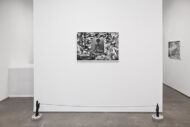Keisha Scarville’s first solo gallery show is a layered visual investigation of how the legacies of slavery permeate the contemporary search for Black identity. Her works wrestle with a sense of invisible division, where splits and separations make the tenuous connections across those divides all the more resonant.
Scarville’s particular family history merges two distinct geographies, Guyana and America (and in particular New York), and then reaches back further to the Middle Passage that brought African slaves to this side of the world. Finding herself caught in between, her photographs probe her desire to define that intermediate condition and find balance within its unresolved state of uncertainty.
Scarville’s self-portraits are rich in ambiguity. We see her from behind, her body turned into a dark silhouette against a white background, and then again lying down, where dark shadows cover her body, revealing only a portion of her head (in one image) and her legs (in a second). Another work uses her outstretched hand as a symbolic stand-in for the self, with two competing shadows (perhaps representing her two geographic histories) cast by the single arm. Still other images further confuse our ability to see the artist clearly, with bent arms that seem to struggle to support her body. In each composition, sharp contrasts of light and dark amplify the maneuvering forms, making the gestures and poses more deliberate and insistent.
Bold, patterned fabrics in black and white (representing both a connection to her mother and more broadly to Africa) provide Scarville with an enveloping cocoon for important objects and her own body. Still life setups place a stone sculpture (of a female head with stylized hair) and a photograph (of a darkly anonymous mother and child) within layers of textiles, providing a supportive context for items that have been otherwise isolated. In other images, the artist’s body is surrounded, covered, and obscured by these fabrics, placing her inside their patterns. It’s clear that these fabrics have deep implications for Scarville, her body repeatedly placed in relation to their vibrancy.
The longer arm of history makes its presence felt in other photographs. Two pictures place that history in an educational context, via a hand-written 5th grade essay about the journey from Africa to the plantations and a “Best Graduating Student in Caribbean History” trophy, both alluding to the fact that what was taught (and learned) about slavery has its own contexts and complexities. Two other images travel back to the seawall where captive slaves boarded boats, making the rough rock a foil for a delicately searching hand and a body struggling within a draping of fabric. Again, Scarville’s images lyrically engage with her own history, using these physical gestures and movements to represent her wider search for identity.
One small sculptural work placed on the floor of the gallery ties many of these ideas together. In it, two separate Black hands rise from concrete platforms, the fingers linked by a long strand of yarn. Perhaps these two hands represent the two geographies of Scarville’s life or the crossing of distances, but they also create the effect of an impossibly low limbo pole, underneath which Black people have danced for centuries. The performative contortions and twists of those histories are felt throughout the show.
As an integrated artistic statement, this show is tightly edited and filled with layered connections, and it’s a promising start for Scarville, whose sensitive picture making grapples with nuanced issues of identity. The show offers no neat or easy answers, but engages us in a process of careful examination, where the artistic struggle of seeking answers encourages Scarville to expressively reimagine how the pieces might fit together.

